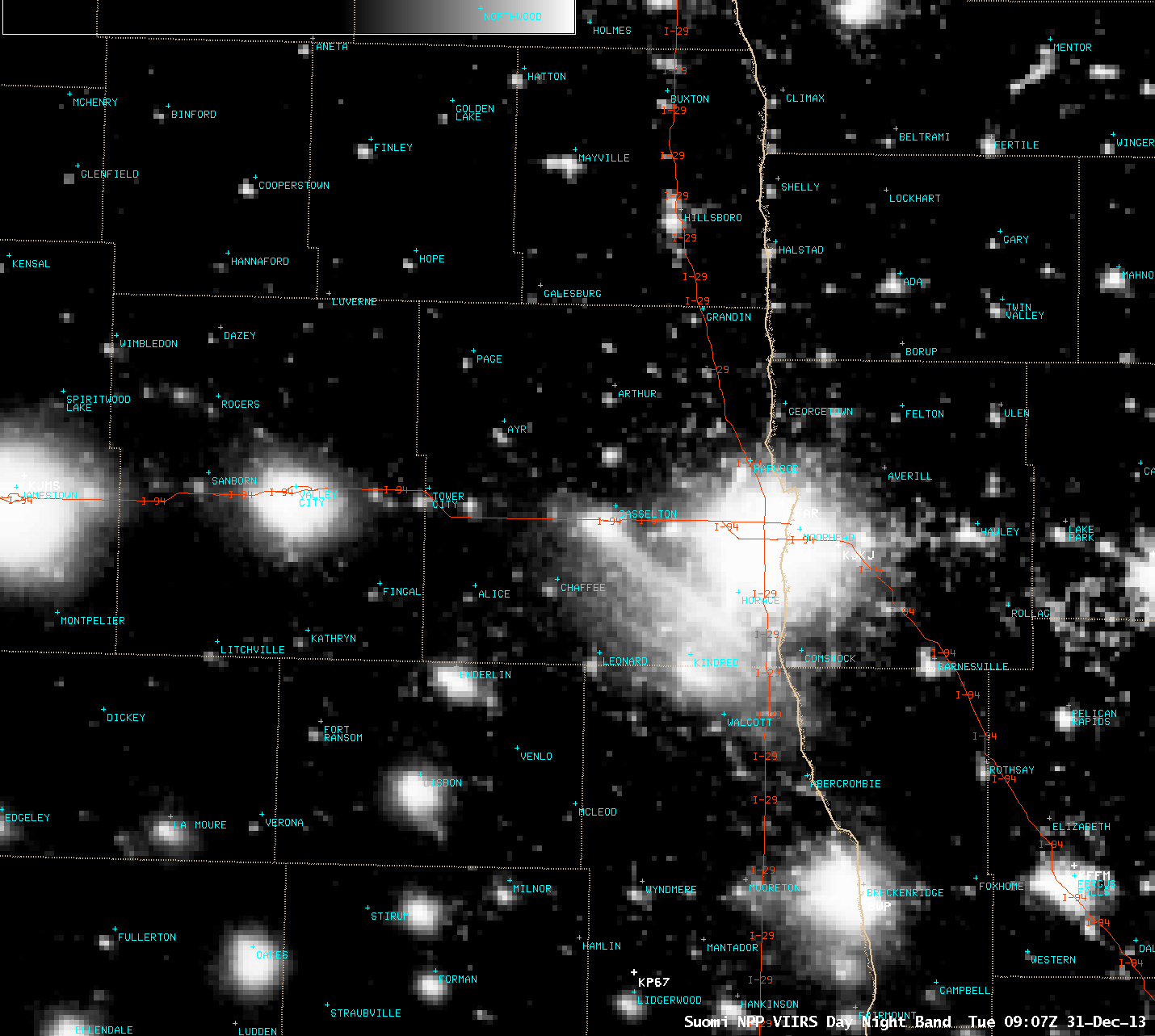Fire following a train derailment and crash in North Dakota
![GOES-13 0.63 µm visible channel (left) and 3.9 µm shortwave IR channel (right) images [click to play animation] GOES-13 0.63 µm visible channel (left) and 3.9 µm shortwave IR channel (right) images [click to play animation]](https://cimss.ssec.wisc.edu/satellite-blog/wp-content/uploads/sites/5/2013/12/1000x1000_GOES_B1_HD_NDFIRE_2013364_211500_1000x1000_GOES_B2_HD_NDFIRE_2013364_211500.gif)
GOES-13 0.63 µm visible channel (left) and 3.9 µm shortwave IR channel (right) images [click to play animation]
A comparison of GOES-15 (GOES-West, positioned at 135º West longitude) and GOES-13 (GOES-East, positioned at 75º West longitude) 0.63 µm visible channel images (below; click image to play animation) showed how the dark smoke plume appeared from the very different viewing perspectives of the two geostationary satellites. On both sets of images the eastern portion of the smoke plume appeared to have drifted over Interstate 29 (I-29) south of Fargo (FAR), but due to the low sun angle it is likely that this was actually the shadow from the dark smoke plume. Note that the low cloud features cast similar shadows during the late afternoon hours toward the end of the animation.
The corresponding comparison of GOES-15 vs GOES-13 3.9 µm shortwave IR images (below; click image to play animation) also showed differences in the apparent intensity of the fire hot spot, which were dependent upon satellite viewing angle, viewing time, and the opacity of the dense smoke plume overhead. On the GOES-13 21:15 UTC image (which was actually scanning the fire area at 21:17 UTC), a notable increase in IR brightness temperature was seen, with the hot spot exhibiting a brightness temperature of 322 K (48.9º C or 120º F). This was likely the near the time of one of several explosions (video 1 | video 2). GOES-15 was not scanning the fire area at that particular time, so a fire hot spot of that intensity was not evident in the imagery.===== 31 December Update =====
The intense oil-fueled fire continued to burn into the following night; an AWIPS image of Suomi NPP VIIRS 0.7 µm Day/Night Band (DNB) data at 09:07 UTC or 3:07 AM local time on 31 December (below) showed the bright glow of the fire near Casselton, as well as the smoke plume which was still drifting to the southeast. The glow of lights from cities and towns appeared somewhat blurry on the DNB image, due to scattering of the light through a thin veil of cirrus clouds that was drifting over the region (VIIRS 11.45 µm IR channel image). Since the Moon was nearly in the New phase, there was very little moonlight to illuminate the smoke plume — airglow and lights from nearby cities and towns helped to make this feature visible on the DNB image. Note that the navigation of the DNB image was slightly off, with the image being shifted a few miles to the southwest; in addition, this particular DNB image was enhanced to provide a darker contrast, eliminating “noise” from the glow of the regional snow cover (which was generally in the 5-13 inch range) to help highlight the smoke plume. A subtle signature of the fire hot spot (a darker gray pixel) could still seen on the corresponding VIIRS 3.74 µm shortwave IR image.
Due to air quality concerns from the toxic smoke plume, residents immediately downwind of the crash site were urged to evacuate. At Fargo’s Hector International Airport (located about 25 miles to the east of Casselton), the surface visibility dropped to 2 miles with haze at 06:53 UTC (12:53 AM local time) on 31 December, as winds shifted to the southwest (time series of surface reports); it is unknown whether this drop in visibility was due to smoke being transported from the accident site, or simply from local sources (such as the widespread burning of firewood in the city, given that the ambient air temperature at the time was -15º F). A WDAY News tower camera photo (below) showed that the dark smoke plume could be seen from downtown Fargo — the tower camera is looking to the west, and the smoke plume is drifting southward (to the left).



